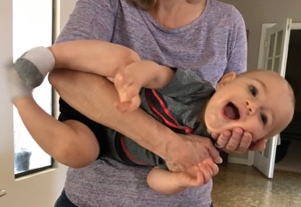The Best Way to Hold and Carry Your Baby
Holding your baby is one of the most joyous and relaxing experiences. It is during these special moments you will bond and enjoy memories of cute smiles, initial communication, and quiet gazing upon your precious baby sleeping in your arms. During the first year of life, you have several opportunities to carry and hold your child, so why not take advantage of some preferred positions to encourage increased strength and independent mobility?
At AzOPT and Kids Place, our pediatric physical therapists specialize in helping parents understand how everyday interactions can positively impact their child’s growth and development.
Why Holding Positions Matter for Development
There are well established and defined holding positions widely accepted across the parenting world. However, some holds are more helpful to encourage improvement with core muscular activation, mid-line orientation, and head control. Increasing strength in these areas will help your child obtain and achieve their gross motor milestones more easily.
Don’t Forget Tummy Time
When you are not holding your baby, tummy time is very important. According to the American Association of Pediatrics, tummy time can begin at birth with newborn children tolerating 3-5-minute sessions, 2-3 times a day during waking hours with adult supervision. At 3 months, your child can be placed on their tummy 10-15 minutes every hour with adult supervision.
Your baby can:
- lie flat on the floor
- elevated over a blanket or boppy (figure 1)
- in the classic football hold
- or prone over your lap
It is recommended to increase tummy time sessions as tolerated. Tummy time is a good work out for your baby. It assists in head control as well as strengthening of the shoulders, arms, abdominal muscles, and back muscles. It is also a fun way to get on the floor and enjoy some play time with your infant.
Recommended Baby Holding Positions and Their Benefits
Football Hold (Prone Over Arm)–
Prone over arm can be a part of tummy time sessions. Place your baby over your forearm supporting their head in the natural bend of your elbow and resting your opposite arm between baby’s legs supporting them with your hand at their tummy or shoulder (figure 2). This position helps to strengthen the baby’s postural muscles and head control.
Football Hold (Traditional) –
Traditional hold placing baby in horizontal side lying while supporting their head with hand as shown or in elbow bend with opposite arm positioned between legs supporting baby’s trunk and shoulder. Baby should want to lift head moving ear towards shoulder to visually scan his environment (figure 3). This position works on improving muscle strength in babies’ neck and side of trunk.
Prone Over Lap –
Place baby with their stomach and legs supported on your lap. Baby is perpendicular to adults’ legs (figure 4). This position can be used as part of tummy time sessions to work on back, neck, and shoulder strengthening.
Lap Hold –
Baby is on his back cradled in parents’ lap. Bring babies legs and feet together (figure 5). This position helps to work on vision gazing down, neck strength, symmetrical play, and lower abdominal strength. Try playing patty cake with baby’s feet to work on awareness of where feet are in space.
Also try your child reaching overhead with both hands to the middle. This positional play works on stomach strength (core), symmetrical play, and arm strength.
Modified Chair Hold
With your baby seated on one leg while the other is elevated, this position promotes trunk strength and head control (Figure 6).
Cradle Hold (with leg elevated) –
Cradle baby against parent chest with hand supporting babies bottom and opposite arm elevating one leg (figure 7). This position helps to strengthen babies’ core and get ready for crawling on hands and knees as well as future walking.
Guitar Hold–
Support baby with arm around chest and bottom in a sideway position (figure 8). This position encourages baby to work on head control and strength.
Facing Outward Suspended Vertically –
Support baby with both hands on the side of the trunk or with your arm across their chest (figure 9). Gently tilt baby to the left and right to promote righting reactions and strength through his core/abdominal muscles.
Remember to perform the above holding positions to each side, left and right, and alternate the elevated leg frequently to avoid your baby becoming stronger on one side compared to the other. If baby becomes fussy, change positions realizing that they may be resistant to that position due to a weakness.
Picking Up Your Baby Safely
When picking baby up from the floor, try an alternative movement pattern. Support baby by placing both hands around chest and under armpits (slightly below). Roll baby to either side then move over babies’ hip to move achieve a seated position with babies legs out in front of their tummy. Continue by picking baby up off the floor to hold in parent arms.
And most importantly, don’t forget to enjoy holding and cuddling with your baby.
Your Partner in Pediatric Physical Therapy
If you have questions about your baby’s development or are concerned about delays, the pediatric physical therapists at Kids Place are here to help. Visit our website to learn more or schedule an appointment.
















